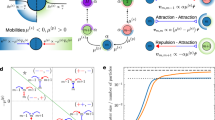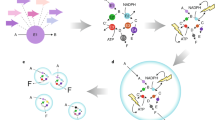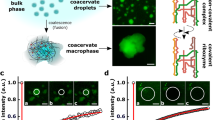Abstract
The evolution of life from the prebiotic environment required a gradual process of chemical evolution towards greater molecular complexity. Elaborate prebiotically relevant synthetic routes to the building blocks of life have been established. However, it is still unclear how functional chemical systems evolved with direction using only the interaction between inherent molecular chemical reactivity and the abiotic environment. Here we demonstrate how complex systems of chemical reactions exhibit well-defined self-organization in response to varying environmental conditions. This self-organization allows the compositional complexity of the reaction products to be controlled as a function of factors such as feedstock and catalyst availability. We observe how Breslow’s cycle contributes to the reaction composition by feeding C2 building blocks into the network, alongside reaction pathways dominated by formaldehyde-driven chain growth. The emergence of organized systems of chemical reactions in response to changes in the environment offers a potential mechanism for a chemical evolution process that bridges the gap between prebiotic chemical building blocks and the origin of life.

This is a preview of subscription content, access via your institution
Access options
Access Nature and 54 other Nature Portfolio journals
Get Nature+, our best-value online-access subscription
$29.99 / 30 days
cancel any time
Subscribe to this journal
Receive 12 print issues and online access
$259.00 per year
only $21.58 per issue
Buy this article
- Purchase on Springer Link
- Instant access to full article PDF
Prices may be subject to local taxes which are calculated during checkout




Similar content being viewed by others
Data availability
All data supporting the findings of this study are available within the paper and Supplementary Data and Supplementary Information. Source data are provided with this paper.
Code availability
All programs used to analyse and plot the data are available on GitHub (https://github.com/huckgroup/formose-2021.git).
References
Surman, A. J. et al. Environmental control programs the emergence of distinct functional ensembles from unconstrained chemical reactions. Proc. Natl Acad. Sci. USA 116, 5387–5392 (2019).
Powner, M. W., Gerland, B. & Sutherland, J. D. Synthesis of activated pyrimidine ribonucleotides in prebiotically plausible conditions. Nature 459, 239–242 (2009).
Foden, C. S. et al. Prebiotic synthesis of cysteine peptides that catalyze peptide ligation in neutral water. Science 370, 865–869 (2020).
Springsteen, G., Yerabolu, J. R., Nelson, J., Rhea, C. J. & Krishnamurthy, R. Linked cycles of oxidative decarboxylation of glyoxylate as protometabolic analogs of the citric acid cycle. Nat. Commun. 9, 91 (2018).
Becker, S. et al. Unified prebiotically plausible synthesis of pyrimidine and purine RNA ribonucleotides. Science 366, 76–82 (2019).
Ritson, D. J., Mojzsis, S. J. & Sutherland, J. D. Supply of phosphate to early Earth by photogeochemistry after meteoritic weathering. Nat. Geosci. 13, 344–348 (2020).
Wołos, A. et al. Synthetic connectivity, emergence, and self-regeneration in the network of prebiotic chemistry. Science 369, eaaw1955 (2020).
Muchowska, K. B., Varma, S. J. & Moran, J. Synthesis and breakdown of universal metabolic precursors promoted by iron. Nature 569, 104–107 (2019).
Stubbs, R. T., Yadav, M., Krishnamurthy, R. & Springsteen, G. A plausible metal-free ancestral analogue of the Krebs cycle composed entirely of α-ketoacids. Nat. Chem. 12, 1016–1022 (2020).
Wu, L.-F. & Sutherland, J. D. Provisioning the origin and early evolution of life. Emerging Top. Life Sci. 3, 459–468 (2019).
Pascal, R., Pross, A. & Sutherland, J. D. Towards an evolutionary theory of the origin of life based on kinetics and thermodynamics. Open Biol. 3, 130156 (2013).
Semenov, S. N. et al. Autocatalytic, bistable, oscillatory networks of biologically relevant organic reactions. Nature 537, 656–660 (2016).
Semenov, S. N. et al. Rational design of functional and tunable oscillating enzymatic networks. Nat. Chem. 7, 160–165 (2015).
Jinich, A. et al. A thermodynamic atlas of carbon redox chemical space. Proc. Natl Acad. Sci. USA 117, 32910–32918 (2020).
Orgel, L. E. Self-organizing biochemical cycles. Proc. Natl Acad. Sci. USA 97, 12503–12507 (2000).
Shapiro, R. Prebiotic ribose synthesis: a critical analysis. Orig. Life. Evol. Biosph. 18, 71–85 (1988).
Sasselov, D. D., Grotzinger, J. P. & Sutherland, J. D. The origin of life as a planetary phenomenon. Sci. Adv. 6, eaax3419 (2020).
Samoilov, M., Arkin, A. & Ross, J. Signal processing by simple chemical systems. J. Phys. Chem. A 106, 10205–10221 (2002).
Roszak, R., Bajczyk, M. D., Gajewska, E. P., Hołyst, R. & Grzybowski, B. A. Propagation of oscillating chemical signals through reaction networks. Angew. Chem. Int. Ed. 58, 4520–4525 (2019).
Urmès, C. et al. Periodic reactor operation for parameter estimation in catalytic heterogeneous kinetics. Case study for ethylene adsorption on Ni/Al2O3. Chem. Eng. Sci. 214, 114544 (2020).
Mettetal, J. T., Muzzey, D., Gomez-Uribe, C. & van Oudenaarden, A. The frequency dependence of osmo-adaptation in Saccharomyces cerevisiae. Science 319, 482–484 (2008).
Kim, H.-J. et al. Synthesis of carbohydrates in mineral-guided prebiotic cycles. J. Am. Chem. Soc. 133, 9457–9468 (2011).
Delidovich, I. V., Simonov, A. N., Taran, O. P. & Parmon, V. N. Catalytic formation of monosaccharides: from the formose reaction towards selective synthesis. ChemSusChem 7, 1833–1846 (2014).
Simonov, A. N. et al. Selective synthesis of erythrulose and 3-pentulose from formaldehyde and dihydroxyacetone catalyzed by phosphates in a neutral aqueous medium. Kinet. Catal. 48, 550–555 (2007).
Iqbal, Z. & Novalin, S. The formose reaction: a tool to produce synthetic carbohydrates within a regenerative life support system. Curr. Org. Chem. 16, 769–788 (2012).
Lambert, J. B., Gurusamy-Thangavelu, S. A. & Ma, K. The silicate-mediated formose reaction: bottom-up synthesis of sugar silicates. Science 327, 984–986 (2010).
Ricardo, A., Carrigan, M., Olcott, A. & Benner, S. Borate minerals stabilize ribose. Science 303, 196–196 (2004).
Colón‐Santos, S., Cooper, G. J. T. & Cronin, L. Taming the combinatorial explosion of the formose reaction via recursion within mineral environments. ChemSystemsChem 1, e1900014 (2019).
Huskey, W. P. & Epstein, I. R. Autocatalysis and apparent bistability in the formose reaction. J. Am. Chem. Soc. 111, 3157–3163 (1989).
Weiss, A. H., LaPierre, R. B. & Shapira, J. Homogeneously catalyzed formaldehyde condensation to carbohydrates. J. Catal. 16, 332–347 (1970).
Weiss, A. H., Socha, R. F., Likholobov, V. A. & Sakharov, M. M. Formose sugars from formaldehyde. Appl. Catal. 1, 237–246 (1981).
Kopetzki, D. & Antonietti, M. Hydrothermal formose reaction. New J. Chem. 35, 1787 (2011).
Haas, M., Lamour, S. & Trapp, O. Development of an advanced derivatization protocol for the unambiguous identification of monosaccharides in complex mixtures by gas and liquid chromatography. J. Chromatogr. A 1568, 160–167 (2018).
Becker, M., Liebner, F., Rosenau, T. & Potthast, A. Ethoximation–silylation approach for mono- and disaccharide analysis and characterization of their identification parameters by GC/MS. Talanta 115, 642–651 (2013).
Becker, M. et al. Evaluation of different derivatisation approaches for gas chromatographic–mass spectrometric analysis of carbohydrates in complex matrices of biological and synthetic origin. J. Chromatogr. A 1281, 115–126 (2013).
Ziemecki, S., LaPierre, R. B., Weiss, A. H. & Sakharov, M. Homogeneously catalyzed condensation of formaldehyde to carbohydrates VI. Preparation and spectroscopic investigation of complexes active in formaldehyde condensation. J. Catal. 50, 455–463 (1977).
Weber, A. L. Prebiotic sugar synthesis: hexose and hydroxy acid synthesis from glyceraldehyde catalyzed by iron(III) hydroxide oxide. J. Mol. Evol. 35, 1–6 (1992).
Khomenko, T. Homogeneously catalyzed formaldehyde condensation to carbohydrates IV. Alkaline earth hydroxide catalysts used with glycolaldehyde co-catalyst. J. Catal. 45, 356–366 (1976).
Kooyman, C., Vellenga, K. & De Wilt, H. G. J. The isomerization of d-glucose into d-fructose in aqueous alkaline solutions. Carbohydr. Res. 54, 33–44 (1977).
Gutsche, C. David et al. Base-catalyzed triose condensations. J. Am. Chem. Soc. 89, 1235–1245 (1967).
Nagorski, R. W. & Richard, J. P. Mechanistic imperatives for aldose−ketose isomerization in water: specific, general base- and metal ion-catalyzed isomerization of glyceraldehyde with proton and hydride transfer. J. Am. Chem. Soc. 123, 794–802 (2001).
Andersen, J. L., Flamm, C., Merkle, D. & Stadler, P. F. Inferring chemical reaction patterns using rule composition in graph grammars. J. Syst. Chem. 4, 4 (2013).
Andersen, J. L., Flamm, C., Merkle, D. & Stadler, P. F. Rule composition in graph transformation models of chemical reactions. MATCH Commun. Math. Comput. Chem. 80, 661–704 (2018).
Simm, G. N. & Reiher, M. Context-driven exploration of complex chemical reaction networks. J. Chem. Theory Comput. 13, 6108–6119 (2017).
Bajczyk, M. D., Dittwald, P., Wołos, A., Szymkuć, S. & Grzybowski, B. A. Discovery and enumeration of organic-chemical and biomimetic reaction cycles within the network of chemistry. Angew. Chem. Int. Ed. 57, 2367–2371 (2018).
Kowalik, M. et al. Parallel optimization of synthetic pathways within the network of organic chemistry. Angew. Chem. Int. Ed. 51, 7928–7932 (2012).
Harsch, G., Bauer, H. & Voelter, W. Kinetik, Katalyse und Mechanismus der Sekundärreaktion in der Schlußphase der Formose-Reaktion. Liebigs Ann. Chem. 1984, 623–635 (1984).
Berl, W. G. & Feazel, C. E. The kinetics of hexose formation from trioses in alkaline solution. J. Am. Chem. Soc. 73, 2054–2057 (1951).
Simonov, A. N., Pestunova, O. P., Matvienko, L. G. & Parmon, V. N. The nature of autocatalysis in the Butlerov reaction. Kinet. Catal. 48, 245–254 (2007).
Delidovich, I. V., Simonov, A. N., Pestunova, O. P. & Parmon, V. N. Catalytic condensation of glycolaldehyde and glyceraldehyde with formaldehyde in neutral and weakly alkaline aqueous media: kinetics and mechanism. Kinet. Catal. 50, 297–303 (2009).
Breslow, R. On the mechanism of the formose reaction. Tetrahedron Lett. 1, 22–26 (1959).
Pross, A. & Pascal, R. How and why kinetics, thermodynamics, and chemistry induce the logic of biological evolution. Beilstein J. Org. Chem. 13, 665–674 (2017).
Horowitz, J. M. & England, J. L. Spontaneous fine-tuning to environment in many-species chemical reaction networks. Proc. Natl Acad. Sci. USA 114, 7565–7570 (2017).
Patel, B. H., Percivalle, C., Ritson, D. J., Duffy, C. D. & Sutherland, J. D. Common origins of RNA, protein and lipid precursors in a cyanosulfidic protometabolism. Nat. Chem. 7, 301–307 (2015).
Harris, C. R. et al. Array programming with NumPy. Nature 585, 357–362 (2020).
SciPy 1.0 Contributors. SciPy 1.0: fundamental algorithms for scientific computing in Python. Nat. Methods 17, 261–272 (2020).
Laine, R. A. & Sweeley, C. C. Analysis of trimethylsilyl O-methyloximes of carbohydrates by combined gas-liquid chromatography–mass spectrometry. Anal. Biochem. 43, 533–538 (1971).
Meyer, D., Friedland, J., Kohn, T. & Güttel, R. Transfer functions for periodic reactor operation: fundamental methodology for simple reaction networks. Chem. Eng. Technol. 40, 2096–2103 (2017).
Hagberg, A. A., Schult, D. A. & Swart, P. J. Exploring network structure, dynamics, and function using NetworkX. in Proc. 7th Python in Science Conference (SciPy 2008) (eds Varoquaux, G., Vaught, T., & Millman, J.) 11–15 (2008).
Acknowledgements
This work was supported by funding from the Simons Collaboration on the Origins of Life (SCOL; award 477123, W.T.S.H., W.E.R.) and the Dutch Ministry of Education, Culture and Science (Functional Molecular Systems Gravity programme 024.001.035, W.T.S.H., W.E.R., E.D., P.D.). The funders had no role in study design, data collection and analysis, decision to publish or preparation of the manuscript. We thank P van Galen, R de Graaf and J del Pozo Mellado for support with GC–MS analysis.
Author information
Authors and Affiliations
Contributions
W.E.R. and W.T.S.H. conceived the research and acquired funding. W.E.R. and E.D. developed the experimental methodology. W.T.S.H. administered the project and resources. All authors contributed to the design of experiments. W.E.R., E.D., P.v.D. and T.d.J. performed the experiments. W.E.R. curated and analysed the data. W.E.R. wrote the data analysis software and developed data visualizations. W.T.S.H. supervised the investigation. W.E.R. and W.T.S.H. wrote the original draft and all authors discussed the results and commented on the manuscript.
Corresponding author
Ethics declarations
Competing interests
The authors declare no competing interests.
Peer review
Peer review information
Nature Chemistry thanks Subhabrata Maiti and the other, anonymous, reviewer(s) for their contribution to the peer review of this work.
Additional information
Publisher’s note Springer Nature remains neutral with regard to jurisdictional claims in published maps and institutional affiliations.
Extended data
Extended Data Fig. 1 Reaction types of the formose reaction.
Detailed reaction types which describe the transformations shown in Fig. 1a (main text).
Extended Data Fig. 2 A detailed schematic of the continuous stirred-tank reactor used in this work.
a Side schematic of the reactor depicting how inputs and the outlet were connected to the reactor and how the temperature was controlled. b Bottom view of the reactor showing the geometry of the inlet holes into the reactor.
Extended Data Fig. 3
The structures of compounds assigned in this work and their corresponding numbering scheme.
Extended Data Fig. 4 Mappings of key conditionals variations across data sets to the leaves of the dendrogram.
a Formaldehyde, b dihydroxyacetone, c CaCl2, d NaOH, e the ratio of CaCl2:NaOH, f The location of glycolaldehyde (2), erythrulose (9) and ribose (19) initiated reactions. The colour bars below each dendrogram indicate mapping of the colour to the value of each condition.
Extended Data Fig. 5 Variation of the composition of the formose reaction with temperature.
Conditions: formaldehyde (200 mM), dihydroxyacetone (25 mM amplitude, 50 mM offset, period 6 min.), CaCl2 (15 mM), NaOH (30 mM).
Extended Data Fig. 6 Variation of the formose reaction’s composition with residence time.
The data were determined from flow reactions at 21 °C, with inputs of dihydroxyacetone (25 mM amplitude, 50 mM offset, period three times the residence time), formaldehyde (200 mM), CaCl2 (15 mM), and NaOH (30 mM). Input concentrations are quoted as the initial concentration of compounds upon entering the continuous stirred-tank reactor.
Extended Data Fig. 7 A proposed mechanism for the selectivity between 14 and 20.
a The C2-C3 reaction to create 14 via a six-membered ring transition state in which α-hydroxymethyl groups adopt lower energy equatorial positions. b A similar reaction and transition state as show in panel a from which compound 20 is formed. Dashed bonds indicate those formed and broken over the course of the reaction.
Extended Data Fig. 8 A proposed mechanism for the selectivity between 12 and 13.
a The open-chain structure of 12. b The open-chain structure of 13. The likely conformation of the six-membered ring formed via coordination of Ca2+ to 12 (c) and 13 (d). Charges (Ca2+, O–) are omitted for clarity.
Supplementary information
Supplementary Information
Supplementary Figs. 1–11.
Source data
Source Data Fig. 2
Data used to create the bar charts in Fig. 2a. Data used to create the traces in Fig. 2c. Data used to create the traces in Fig. 2e.
Source Data Fig. 3
Data used to create the traces in Fig. 3a. Data used to create the heatmap in Fig. 3d.
Rights and permissions
About this article
Cite this article
Robinson, W.E., Daines, E., van Duppen, P. et al. Environmental conditions drive self-organization of reaction pathways in a prebiotic reaction network. Nat. Chem. 14, 623–631 (2022). https://doi.org/10.1038/s41557-022-00956-7
Received:
Accepted:
Published:
Issue Date:
DOI: https://doi.org/10.1038/s41557-022-00956-7
This article is cited by
-
Computational synthesis design for controlled degradation and revalorization
Nature Synthesis (2024)
-
Small-molecule autocatalysis drives compartment growth, competition and reproduction
Nature Chemistry (2024)
-
Complex networks at life’s origins
Nature Chemistry (2022)
-
Nucleobases in Meteorites to Nucleobases in RNA and DNA?
Journal of Molecular Evolution (2022)



